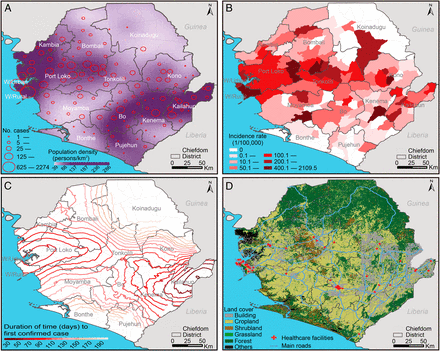Li-Qun Fang, Yang Yang, Jia-Fu Jiang, Hong-Wu Yao, David Kargbo, Xin-Lou Li, Bao-Gui Jiang, Brima Kargbo, Yi-Gang Tong, Ya-Wei Wang, Kun Liu, Abdul Kamara, Foday Dafae, Alex Kanu, Rui-Ruo Jiang, Ye Sun, Ruo-Xi Sun, Wan-Jun Chen, Mai-Juan Ma, Natalie E. Dean, Harold Thomas, Ira M. Longini, Jr., M. Elizabeth Halloran, Wu-Chun Cao
Proceedings of the National Academy of Sciences
March 28, 2016
abstract
Sierra Leone is the most severely affected country by an unprecedented outbreak of Ebola virus disease (EVD) in West Africa. Although successfully contained, the transmission dynamics of EVD and the impact of interventions in the country remain unclear. We established a database of confirmed and suspected EVD cases from May 2014 to September 2015 in Sierra Leone and mapped the spatiotemporal distribution of cases at the chiefdom level. A Poisson transmission model revealed that the transmissibility at the chiefdom level, estimated as the average number of secondary infections caused by a patient per week, was reduced by 43% [95% confidence interval (CI): 30%, 52%] after October 2014, when the strategic plan of the United Nations Mission for Emergency Ebola Response was initiated, and by 65% (95% CI: 57%, 71%) after the end of December 2014, when 100% case isolation and safe burials were essentially achieved, both compared with before October 2014. Population density, proximity to Ebola treatment centers, cropland coverage, and atmospheric temperature were associated with EVD transmission. The household secondary attack rate (SAR) was estimated to be 0.059 (95% CI: 0.050, 0.070) for the overall outbreak. The household SAR was reduced by 82%, from 0.093 to 0.017, after the nationwide campaign to achieve 100% case isolation and safe burials had been conducted. This study provides a complete overview of the transmission dynamics of the 2014−2015 EVD outbreak in Sierra Leone at both chiefdom and household levels. The interventions implemented in Sierra Leone seem effective in containing the epidemic, particularly in interrupting household transmission.

